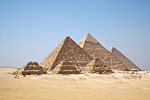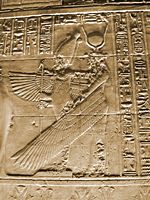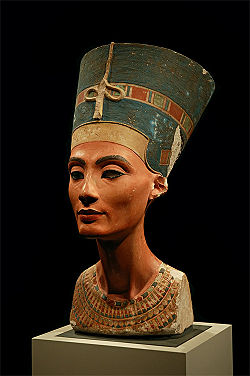Portal:Ancient Egypt
2008/9 Schools Wikipedia Selection. Related subjects: History; Portals
The culture of Ancient Egypt lived along the Nile river in Egypt from before the 5th millennium BC until the 4th Century AD. Ancient Egyptian society was based on farming the fertile Nile valley which flooded every year, enriching the soil with nutrients. The government of ancient Egypt, headed by the Pharaoh, was responsible for organizing farming efforts and collecting taxes for the state, which protected the country's borders and built grand monuments to the gods. The ancient Egyptian civilization effectively ended after the Roman domination, but the pyramids and colossal statues they left behind stand as testimony to the power of the pharaohs.
Ancient Egyptian religion encompasses the beliefs and rituals of Ancient Egypt. It was followed in Egypt for over three thousand years until the establishment of Coptic Christianity and Islam. Throughout the vast and complex history of Egypt, the dominant beliefs of the ancient Egyptians merged and developed as leaders of different groups gained power. This process continued even after the end of the ancient Egyptian civilization as we know it today. As an example, during the New Kingdom Ra and Amun became Amun-Ra. This "merging" into a single deity is typically referred to as syncretism.
More
Bust of Nefertiti.Nefertiti (pronounced at the time something like *nafratiːta (c. 1370 BC - c. 1330 BC) was the Great Royal Wife (or chief consort/wife) of the Egyptian Pharaoh Akhenaten. She was the mother-in-law and probable stepmother of the Pharaoh Tutankhamun.
...that a dagger found in Tutankhamun's tomb, KV62, is made from meteoric iron?
...that the Rosetta Stone was the key to deciphering hieroglyphs in 1822 by Jean-François Champollion, and in 1823 by Thomas Young?
...that Dr. Zahi Hawass (Arabic: زاهى حواس ) is one of the world's foremost Egyptologists, and is currently the Secretary General of the Egyptian Supreme Council of Antiquities?
...that Cleopatra's Needle in London, UK was actually constructed at the time of Thutmose III, around 1450 BC, and has nothing to do with the famous queen Cleopatra VII of Egypt?
...that a seal found in the tomb of the Second Dynasty king Peribsen contains the first full sentence written in Egyptian hieroglyphs?
Professor Sir William Matthew Flinders Petrie FRS ( 3 June 1853 – 28 July 1942), known as Flinders Petrie, was an English Egyptologist and a pioneer of systematic methodology in archaeology. He excavated at many of the most important archaeological sites in Egypt such as Abydos and Amarna.
Petrie was encouraged to pursue his interest in archaeology from an early age, and the accurate surveying techniques he learned from his father were put to use in his 1880 survey of the Great Pyramid at Giza, making him the first to investigate properly how they were constructed. On that visit he was appalled by the rate of destruction of monuments and he described Egypt as "a house on fire, so rapid was the destruction" and felt his duty to be that of a "salvage man, to get all I could, as quickly as possible and then, when I was 60, I would sit and write it all down."
Petrie took complete control over his excavations and removed the pressure on the workmen to find treasures quickly but sloppily. Though he was regarded as an amateur and dilettante by more established Egyptologists, his careful attention to detail and investigation of the seriation of pottery allowed him to accurately establish the chronologies of ancient sites. In 1923, Petrie was knighted for his services. Petrie's innovative and careful excavations cataloged in his 97 books revolutionized the study of ancient Egypt and cemented his legacy as the founder of modern Egyptology.
The remains of an unidentified Old Kingdom pyramid were rediscovered at Saqqara in June 2008, along with a section of an avenue of sphinxes dating to the Ptolemaic period.
In March 2008, the Temple of Hathor at Dendara reopened after a site-management program. Visitors are welcomed at a new visitor's centre, and can see a replica of the famous zodiac ceiling now in the Louvre. The main temple dates from the time of Ptolemy XII in the 1st century BC.
In February 2008, an American archaeological mission from UCLA found an almost intact Neolithic settlement and the remnants of a Graeco-Roman village in the Faiyum. The discovery may change archaeologists' understanding of the dating and sequence of the Faiyum Neolithic period.
In January 2008, a Russian-American archaeological mission discovered a group of well-preserved Graeco-Roman mummies in the Faiyum. Also found were a gilded mask, jewelery, and textile fragments. A facial reconstruction of one female mummy is planned.
In May 2007 the intact tomb of the courtier Henu was discovered at Deir el-Bersha and dates from the late First Intermediate Period. The tomb was accidentally uncovered by a Belgian archaeological team from the Katholieke Leuven University. The tomb contained a collection of wooden models of daily life scenes, a coffin and painted statue of the deceased. The find shows that the necropolis at the site was in use after the end of the Old Kingdom.
- Austria
- Kunsthistorisches Museum, Vienna, Austria
- Canada
- Royal Ontario Museum, Toronto, Ontario
- Redpath Museum, McGill University, Montreal
- Egypt
- Cairo Museum of Egyptian Antiquities
- Gayer-Anderson Museum
- Grand Egyptian Museum
- Imhotep Museum
- Luxor Museum
- Luxor Mummification Museum
- France
- Germany
- Egyptian Museum of Berlin – Ägyptisches Museum und Papyrussammlung
- Staatliche Sammlung für Ägyptische Kunst in Munich
- Roemer-und-Pelizaeus-Museum, Hildesheim
- Ägyptologische Sammlung der Universität Heidelberg
- Kestner-Museum Hannover
- Ägyptisches Museum Leipzig
- Italy
- Museo Egizio, Turin
- Palermo Archeological Museum
- Turkey
- Istanbul Archaeology Museum
- United Kingdom
- Ashmolean Museum
- British Museum
- Petrie Museum of Egyptology
- United States of America
- Brooklyn Museum of Art
- Carnegie Museum of Natural History
- Field Museum of Natural History
- Metropolitan Museum of Art
- Museum of Fine Arts, Boston
- Oriental Institute
- University of Pennsylvania Museum of Archaeology and Anthropology



